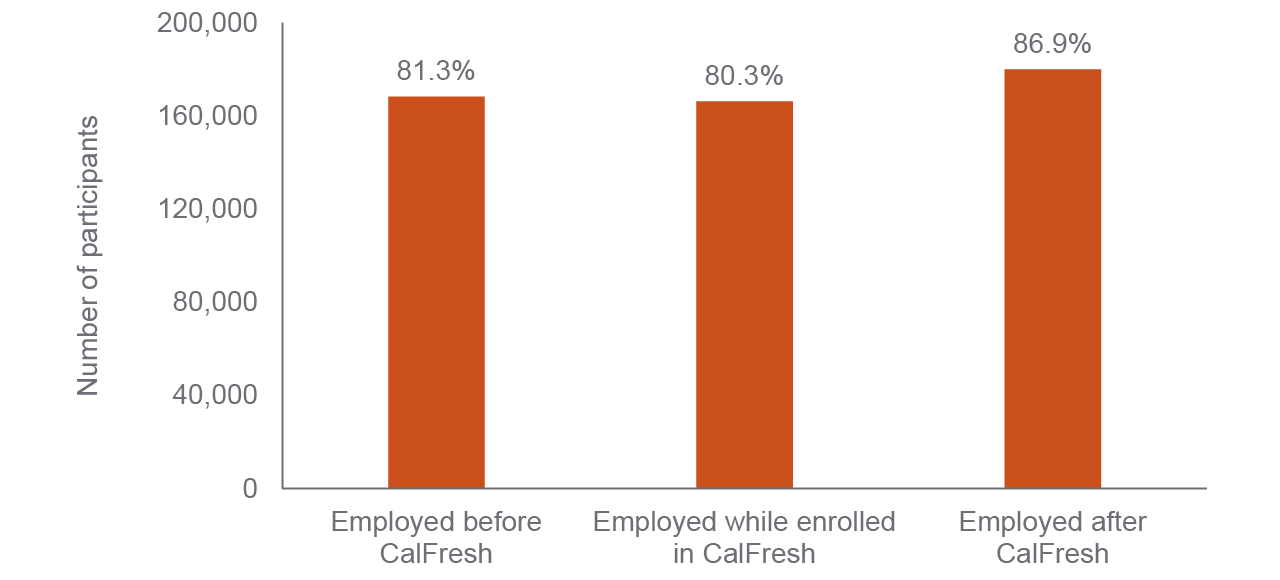CalFresh is California’s implementation of the federal Supplemental Nutrition Assistance Program (SNAP). The program is largely funded by the federal government, which also determines how CalFresh benefits change with income. The state determines some aspects of eligibility and oversees county administration of the program.
In good economic times, most working-age adults new to CalFresh have some connection to the labor market. But work may be unstable, in low-wage jobs that are short-term or temporary. Because CalFresh helps families afford food, it effectively supplements income when work decreases or disappears. For single adults, CalFresh can play a major role, as one of few safety net programs for which they are eligible.
Examining the nature of work for CalFresh participants can help policymakers understand the employment dynamics at play that may influence the duration and impact of benefits. Such insights can point to areas where program requirements might better align with the needs of low-income working Californians.
- Most working-age adults who are new to CalFresh have a job at some point before they enroll.
- Disruptions to work are common: nearly 80% of working participants spend at least one quarter before, during, or after CalFresh without employment.
- For adults who work before and after CalFresh, earnings on average increase by 68.4%.
What is the employment situation for adults who join CalFresh?
Work is extremely common for new CalFresh participants, but unemployment and job instability are prevalent even in good economic times. To describe a “best case” scenario, we examined about a four-year span before, during, and after participants enrolled in CalFresh, at a time that the state’s economy was growing strongly—between 2014 and 2017.
The vast majority—over 83%—of adults who join CalFresh have earnings while they receive benefits, or in the 18 months before or after. More than four in five have jobs at these times—with the greatest share employed after leaving CalFresh. Although nearly all hold at least one longer-term job, about two-thirds have short-term work. Single adults—particularly men—are more likely than others to have short-term jobs, and less likely to have longer-term jobs.
How does employment change around CalFresh?
Almost 80% of all working adults new to CalFresh experience unemployment, but rates fall over the span of CalFresh enrollment; that is, people may seek assistance when times are hardest, and that assistance may help some stay connected to the workforce. About 60% of working participants experience unemployment before enrolling, but while enrolled, 53% have a quarter of unemployment. After CalFresh, the rate is 51%.
Work instability is more common outside of periods of CalFresh assistance than during enrollment. Adults are less likely to have short-term work while enrolled in CalFresh than before, but slightly more likely to hold a short-term job afterwards. Chances also go up slightly that participants hold a longer-term job after leaving CalFresh.
Most working adults new to CalFresh are employed during or near the time they are enrolled

SOURCE: Authors’ analysis of SNAP LDB and EDD Base Wage files, 2012–2019.
NOTE: Adults age 25–54 with any UI-covered earnings in 18 months before, during, and 18 months after CalFresh enrollment as share of those who ever have earnings. Columns not mutually exclusive.
How does income change for participants after leaving CalFresh?
Earnings go up for adults with somewhat stable ties to work, but there are disparities. For white men and Black women, earnings rise about 60%, while Latina participants see gains of about 36%. Men in cases with children see up to 55% higher earnings than single men. Overall, earnings rise less for women than for men, despite women gaining more time in longer-term jobs. Earnings also grow less for participants who return to CalFresh within a few months.
How can policy better support CalFresh participants?
Given that most CalFresh adults work, policymakers and administrators should ensure that processes for getting and keeping benefits accommodate workers. Work instability may play a role in whether participants rise out of or fall back into income eligibility. At the federal level, creating more flexibility around income eligibility when people recertify for CalFresh might prevent such churn. At the same time, California should continue to find ways to help eligible families keep their benefits when it is time to update their information with the county.
Understanding whether CalFresh helps workers move into stable, higher-paying jobs also could inform efforts to smooth transitions out of CalFresh and assist those who churn back on. Single, working adults in CalFresh face greater work instability than those with children. Policymakers should consider how to leverage CalFresh to reach this group of low-income Californians.



